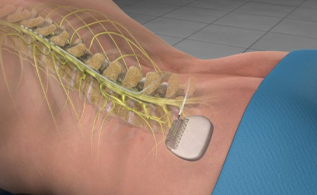Spinal Cord Stimulation

Since its inception in the early 1970’s, this novel therapy has evolved to become one of the most promising innovations in the field of Pain Medicine. Studies have shown it is effective for the relief of a variety of pain syndromes, from pain after spinal surgery to chronic angina, and cost effective for the health budget.
New modes of applying spinal cord stimulation continue to push the boundaries of what we thought possible for this therapy. Burst and high frequency stimulation, as well as combined modality programs are providing patients with more individual programming options and flexibility. Paraesthesia-free stimulation and “closed loop” stimulation are new features meeting the needs of stimulation patients.
Device battery life, recharging options and general durability continue to improve as the systems for delivering effective pain relief via spinal cord stimulation rapidly evolve in response to patients’ needs.
Spinal Cord Stimulation
Spinal Cord Stimulation (SCS) is an exciting and relatively new development in the field of Pain Medicine. It provides a way to alter the experience of pain by modulating cell-to- cell communication of pain signals within the spinal cord. The overall effect is to reduce the experience of pain.
This treatment involves the insertion of small electrodes near the spinal cord that transmit electrical impulses. A small battery powered impulse pulse generator (IPG) that is secured beneath the skin provides energy to the electrodes. Various patterns or programmes of stimulation with electrical current are now available to optimise the pain relief each patient experiences. Each patient will work closely with their Pain Specialist and SCS device technician to individually tailor their most effective programme.
Any surgical or invasive procedure carries risks. Before proceeding, you should seek a second opinion from an appropriately qualified health practitioner. Northern Pain Centre can facilitate you obtaining a second opinion. Please discuss this with us.
What conditions can SCS treat?
Spinal Cord Stimulation is most commonly used to treat back, leg (‘sciatica’) or arm pain that has not responded to spinal surgery. Spinal Cord Stimulation can also be effective in treating Complex Regional Pain Syndrome (CRPS) and persistent pain following injury or surgery. Research has also shown that it can be effective in other neuropathic pain conditions.
There are many different spinal cord stimulator devices available for the management of chronic pain. At Northern Pain Centre, our interventional pain specialist determine the appropriate spinal cord stimulator for patients by assessing each patient independently and using up-to-date clinical research and current best practice.
 Trial Phase
Trial Phase
Patients will undergo a temporary trial for 7-10days to determine the effectiveness of the device. A SCS trial involves temporary electrodes being placed within the epidural space and attached to an external trial device that is worn on a belt by the patient for the trial duration. During the trial phase, our patients will complete a daily pain diary to record their progress. At the completion of the trial, the leads will be removed, and a decision will be made whether to proceed to permanent implant.
Permanent Phase
A SCS permanent implant involves permanent electrodes being placed within the epidural space and attached to a small impulse generator/battery, which is implanted under the skin in a site chosen by the patient and pain specialist.
Animation of Spinal Cord Stimulator Implant Procedure
Video courtesy of Bionic Medical Institute
Ongoing management
Often patients will require ongoing support by their health care team and device company to manage the device and any residual pain.
Learn more
- Download a copy of our Spinal Cord Stimulation brochure click here
- Northern Pain Centre Patient Education Sheet – Preoperative Medication List – Category B
- International Neuromodulation Society: Spinal Cord Stimulation
Spinal Cord Stimulator Company Resources
Listed in alphabetical order.
Abbott Medical
- Proclaim IPG Product Manual
- Proclaim DRG Product Manual
- Prodigy MRI IPG Product Manual
- Abbott Medical Website
- Clinical Research
- Patient Information
Boston Scientific
- GP Frequently Asked Questions
- Boston Scientific Website
- Boston Scientific Product Information
- Clinical Research
- Patient Information
Medtronic
Nevro Medical
- GP Frequently Asked Questions
- Senza IPG Product Manual
- Nevro MRI Information
- Nevro Medical Website
- Clinical Research
- Senza RCT
- Patient Information
Saluda Medical
- Saluda Medical overview Evoke system (link)
- How closed loop chronic pain therapy works (link)
- Patient Brochure (link)
- Clinical Research: ECAP-Controlled Closed-Loop Spinal Cord Stimulation Efficacy and Opioid Reduction Over 24-Months: Final Results of the Prospective, Multicenter, Open-Label Avalon Study (link)
- The Lancet: Long-term safety and efficacy of closed-loop spinal cord stimulation to treat chronic back and leg pain (Evoke): a double-blind, randomised, controlled trial. Read here
- Jan 2020 Article: Closed-Loop Spinal Cord Stimulation for the Management of Chronic Back and Leg Pain [Part 1]
- Jan 2020 Article: Closed-Loop Spinal Cord Stimulation for the Management of Chronic Back and Leg Pain [Part 2]: Expert Perspective
- Click here to view the video on 9news.com.au.
- Visit the Saluda Medical website for more information.
- Catalyst: When Pain Persist
